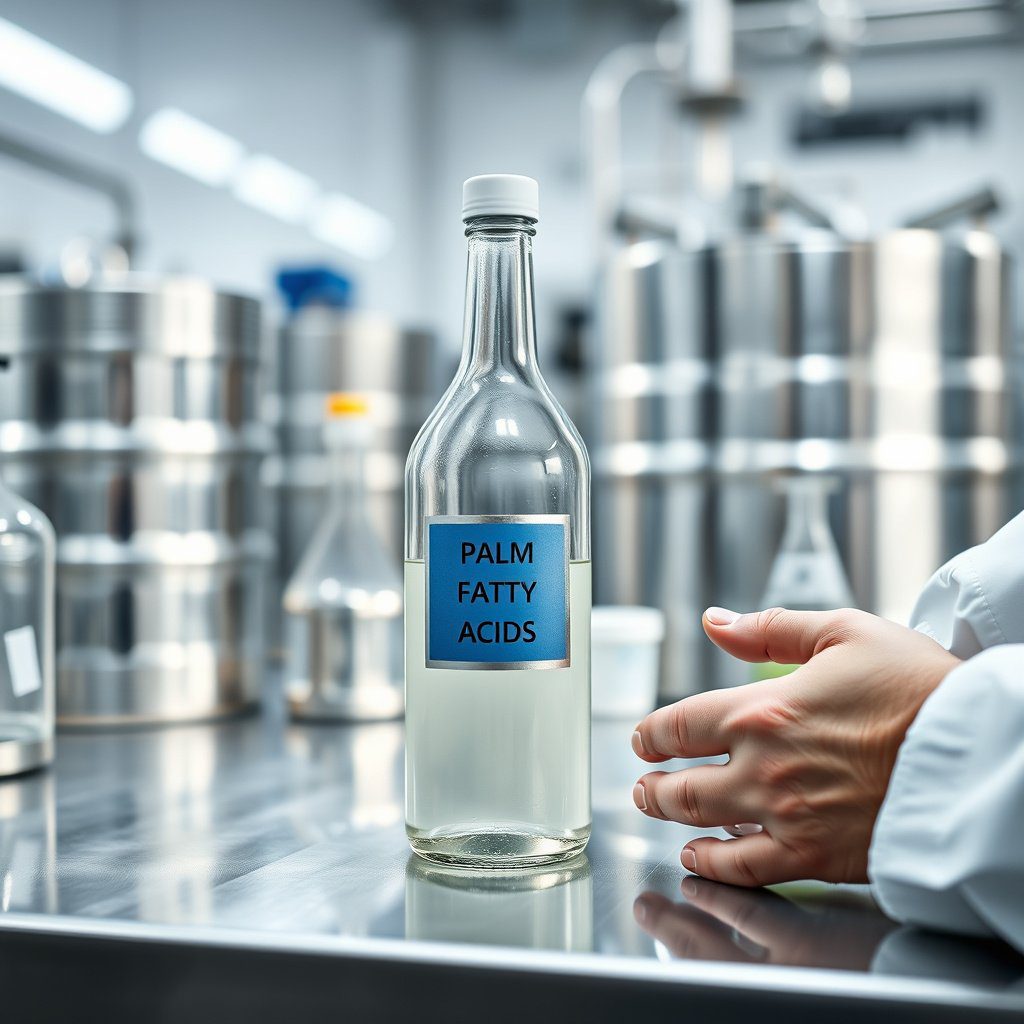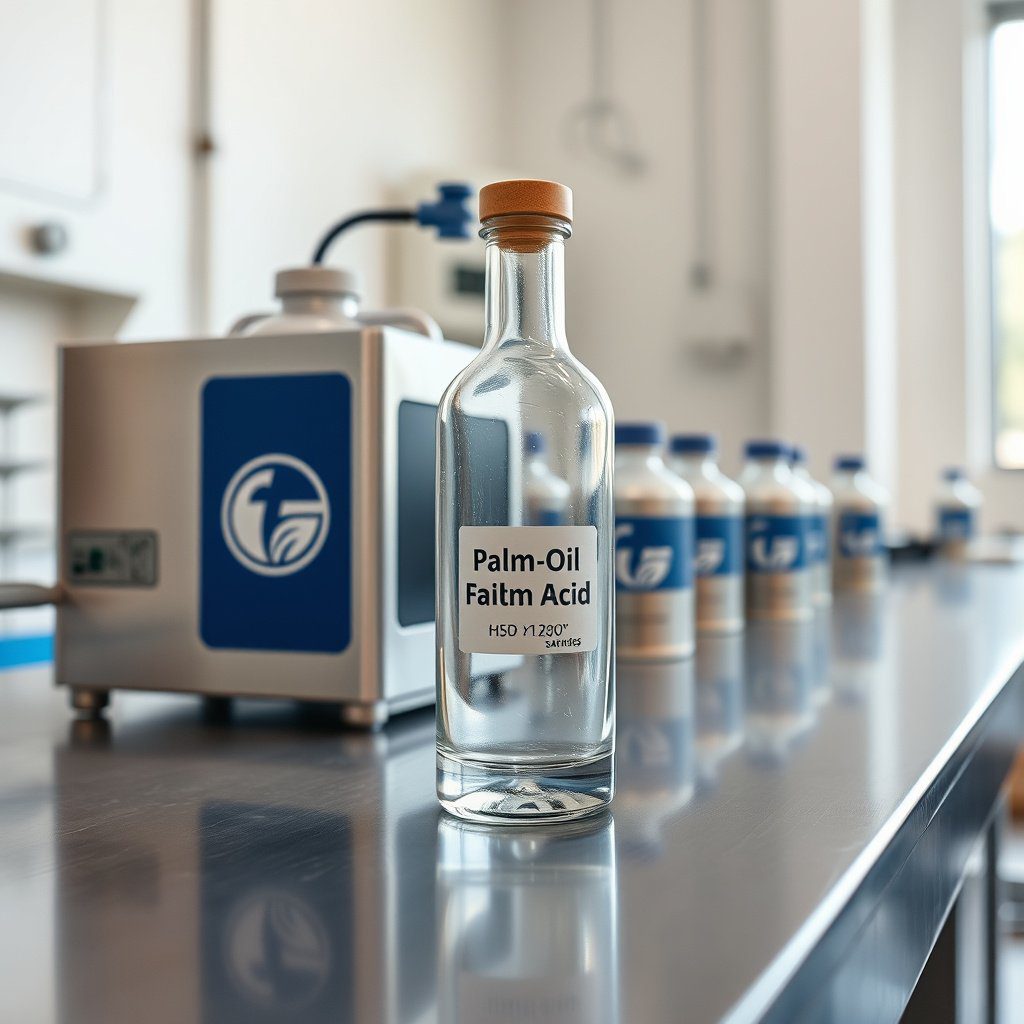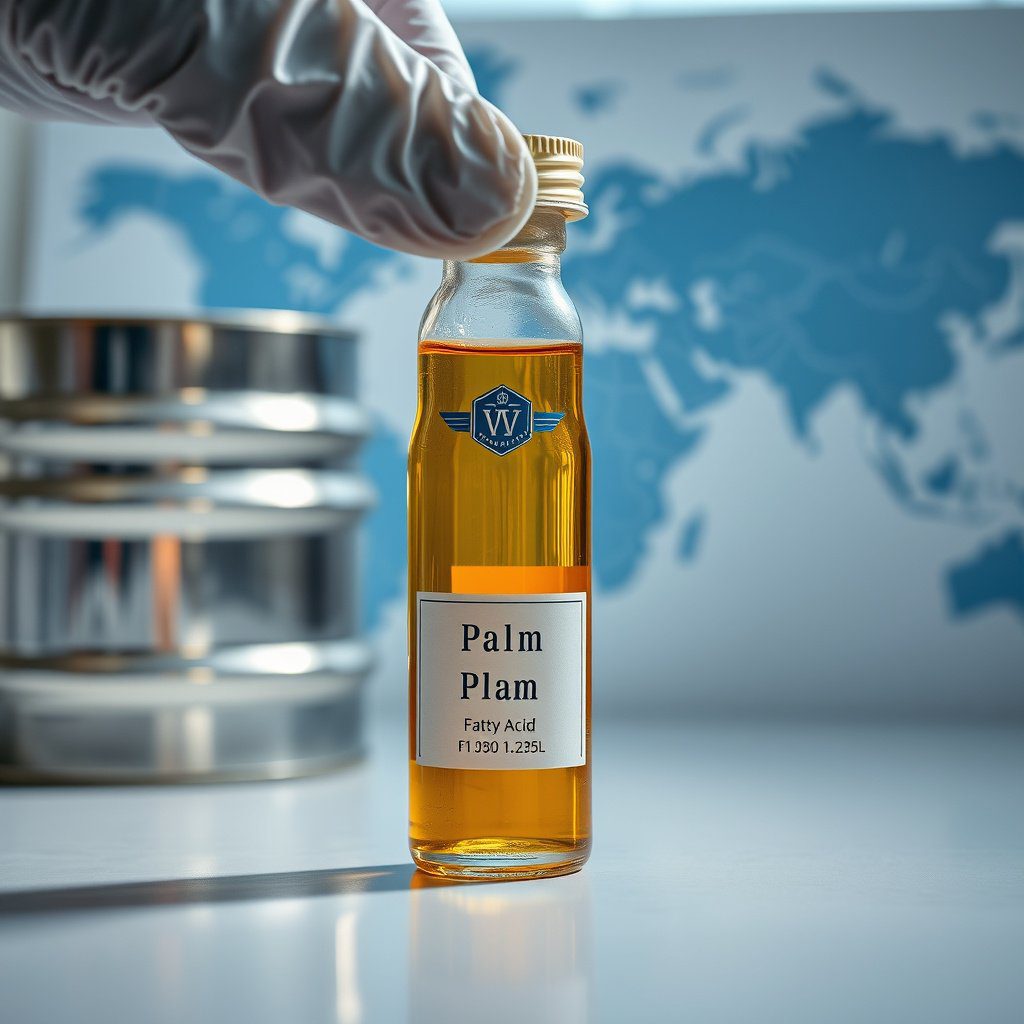In the world of oleochemicals, Palm Fatty Acids are a strategic input for countless manufacturers across HPPC, pharma, and nutrition.
Getting them from source to shelf involves more than price per ton; it requires a resilient, transparent logistics plan that aligns with regulatory requirements, supplier capabilities, and market dynamics.
Diplomata Comercial—a reference in chemical and oleochemical supply for over two decades—has built a robust, global distribution network that translates technical know-how into reliable, scalable operations.
Our approach blends industry-grade quality, end-to-end visibility, and disciplined risk management to help you secure consistent supply, even when markets swing.
When you think about Logistics for Palm Fatty Acids, you’re considering a multi-faceted puzzle: freight rates, tariff regimes, documentation, and the continuous choreography of production schedules, port turns, and inland transport.
The objective is simple in theory—minimize disruption and safe-guard quality—yet achieving it requires practical methods, a trustworthy partner, and data-informed decisions.
In this guide, you’ll find actionable insights, grounded in real-world practice, to help your team optimize costs, navigate tariffs, and sustain performance across regions.
Palm Fatty Acids in Global Trade: Key Cost Drivers in Shipping and Tariffs
Shipping and tariffs form the cornerstone of the total landed cost for Palm Fatty Acids.
Understanding the major cost drivers helps procurement and logistics teams negotiate better terms, select the right Incoterms, and forecast budgeting with greater accuracy.
Across our two decades of operation, we’ve seen how small decisions ripple into meaningful financial outcomes when moving a specialty chemical commodity through complex supply chains.
Think of this section as a practical map of cost layers—what to expect, where to negotiate, and how to protect margins without compromising reliability.
What Drives the Shipping Bill for Palm Fatty Acids
Ocean freight is typically the largest line item, but it sits atop a stack of components that include packaging, inland movement, insurance, and port handling.
Factors such as vessel availability, berth congestion, and seasonal demand influence freight rates, while the physical properties of palm fatty acids—viscosity, bulk density, and compatibility with handling equipment—impact container configuration and loading efficiency.
Our teams routinely optimize packaging and palletization to reduce damage risk and simplify transloading, which translates into fewer claims and smoother customs clearance. Freight terms (FOB, CIF, or DAP) determine who bears which costs and risks at what points during transit, a choice that can shift cash flow timing and insurance coverage.
We help clients compare scenarios, emphasizing supply chain visibility and risk-adjusted budgeting to avoid surprise charges at the port of destination.
Beyond the base freight rate, you’ll encounter ancillary costs that accumulate quickly if left unmanaged.
Insurance premiums reflect cargo value, transport route risk, and coverage level.
Demurrage and detention charges relate to container dwell times at ports and rail/road hubs, especially in peak seasons.
Packaging and handling fees are sensitive to changes in pallet size, stacking limits, and the need for specialized containment for palm fatty acids.
In our experience, a well-designed packaging standard and a pre-approved packaging supplier can drop damage rates and reclaim costs, ultimately improving the predictability of landed cost.
Another critical factor is the mode of transport and route selection.
When possible, we advocate for routes with robust port infrastructure, predictable turnaround times, and reliable inland connections.
This reduces the likelihood of missed connections and last-minute surcharges.
Our recommendations consistently prioritize route optimization and transit-time certainty, because time is money in chemical logistics, and delays often cascade into quality and compliance risks later in the chain.
Incoterms and Their Impact on Palm Fatty Acids Economics
The choice of Incoterms is a strategic decision that shapes who pays for freight, who bears risk at various points, and how quickly the buyer can take control of the goods.
For Palm Fatty Acids, common terms include FOB, CIF, and DAP, each with distinct implications for cash flow and risk management.
Our experience shows that the best term is not always the cheapest per ton; it’s the term that aligns with your internal handling capabilities, insurance strategy, and customs readiness.
We work with you to map out a term-by-term comparison that highlights:.
- Responsibility for loading and unloading,
- Who arranges and pays for insurance,
- Points where risk transfers from seller to buyer,
- Customs clearance responsibilities and document flow.
Choosing the right Incoterms reduces friction during transit and improves predictability when coordinating with customs brokers, freight forwarders, and inland carriers.
Our specialists provide scenario analyses that demonstrate how each term affects working capital, tax exposure, and regulatory compliance across key markets.
Shipping Costs for Palm Fatty Acids: A Practical Breakdown
When you translate the gallon-to-ton math into a practical budgeting exercise, several discrete line items emerge.
This section translates those items into actionable steps your team can take to tighten control over the shipping cost equation while maintaining reliability and compliance.
The goal is to turn opaque price quotes into transparent, negotiable terms that support scale and continuity of supply.
Freight Components You Should Budget For
In addition to the base ocean freight rate, your landed cost will reflect:
- Container or bulk handling requirements,
- Fuel surcharges and currency adjustments,
- Documentation and port-related services,
- Freight forwarder and broker fees,
- Insurance and risk coverage,
- Final-mile inland transport and storage,
Proactive management of these components includes pre-qualifying logistics partners, establishing standardized documentation packs, and negotiating bundled service agreements that cover multiple shipments.
In our practice, standardized containers, early-bird booking, and consolidated shipments reduce variability and unlock rate protection with forward-looking commitments.
Packaging, Palletization, and Storage Considerations
Palm fatty acids are sensitive to storage conditions, temperature stability, and handling friction.
Packaging choices impact both protection during transit and the ease of loading/unloading.
We favor modular packaging that supports efficient palletization and minimizes dust, leakage, and contamination risks.
When feasible, packaging with clear labeling and standardized pallet footprints improves handling across ports and inland nodes, which lowers the risk of damage and improves throughput at inspection points.
Storage at destination—whether in a downstream warehouse or in-line during production scheduling—must preserve product integrity.
Our team collaborates with your QA and warehouse teams to establish durable storage plans, including ventilation considerations, spill response readiness, and routine quality checks that catch issues before they affect downstream processes or regulatory compliance.
Insurance, Demurrage, and Contingencies
Insurance coverage reduces financial exposure due to loss, theft, or damage, but it also requires proper documentation and accurate valuation.
Demurrage and detention charges can be minimized by tight scheduling, reliable port calls, and proactive container tracking.
We encourage clients to build contingency plans that address potential port delays, rerouting needs, or supplier downtime, ensuring you maintain supply continuity without inflating costs.
To support these efforts, our global network provides real-time visibility dashboards, alerting you to deviations in schedule, documentation status, or manifest data.
This enables rapid decision-making and negotiation with carriers to minimize penalties or secure preferential handling when disruptions occur.
Tariffs, Duties, and Compliance Across Regions
Tariffs and customs duties are a moving target shaped by regional trade agreements, regulatory changes, and bilateral policy shifts.
For Palm Fatty Acids, tariff classifications (HS codes), valuation methods, and origin rules determine the landed cost and eligibility for preferential treatment.
In practice, effective tariff management combines strategic supplier selection, accurate product classification, and disciplined compliance practices.
Diplomata Comercial draws on global exposure to help clients manage risk without compromising speed to market.
Tariff Structures by Region: US, EU, Asia
Tariff regimes vary by country and product type, and palm fatty acids may fall under different tariff lines across jurisdictions.
We help clients understand how sector-specific rules interact with regional preferences, free trade agreements, and local regulatory regimes.
This awareness informs decisions around supplier location, shipping routes, and documentation—critical steps to avoid overpayment or delays at customs.
For reference, international trade resources from Trade Administration and the World Trade Organization provide a backdrop for policy context and general guidance.
Beyond rates, regional requirements such as product labeling, safety data sheets, and compliance certifications impact both cost and cycle time.
A systematic approach to document readiness reduces clearance delays and supports smooth imports into destinations with rigorous regulatory expectations.
HS Codes, Valuation, and Customs Documentation
The right HS code assignment and accurate valuation are essential to determine duties, taxes, and eligibility for relief programs.
Misclassification or undervaluation risks penalties and post-entry adjustments.
Our team helps ensure proper product identification, alignment with customs rulings, and a robust document package, including:.
- Commercial invoices with accurate unit pricing,
- Certificates of analysis and quality data,
- Technical data sheets and safety documentation,
- Origin declarations and supplier declarations of conformity.
Clear documentation reduces the likelihood of misclassification and expedites clearance, especially in markets with strict risk control and post-clearance verification processes.
Customs Documentation and Compliance Programs
A proactive compliance program shortens the time from arrival to release and lowers the risk of storage penalties.
We recommend a tiered approach that aligns with shipment size and destination complexity: baseline documentation for routine movements, enhanced packages for high-risk routes, and a dedicated compliance lead for your most strategic markets.
Our approach emphasizes traceability, auditable records, and vendor compliance with global sourcing standards.
To support your teams, we provide templates, checklists, and pre-approved document bundles that streamline submissions to customs brokers.
This minimizes back-and-forth and speeds the journey from port to plant floor.
Best Practices for Reliable Palm Fatty Acids Logistics
Reliability in Palm Fatty Acids logistics arises from disciplined supplier collaboration, proactive planning, and technology-enabled visibility.
This section distills the practical practices we’ve refined through years of global sourcing, import-export operations, and close work with manufacturers across diverse industries.
The emphasis is on tangible steps you can implement to elevate service levels while controlling costs.
Partner Selection: What to Look For in a Global Supplier
Choosing a supplier-distributor with scale, technical know-how, and robust risk management is foundational.
Look for partners who demonstrate:.
- A track record of consistent quality across lots and batches,
- A transparent, auditable supply chain with end-to-end traceability,
- Global reach paired with local execution capabilities in key markets,
- Responsive customer support and collaborative planning processes,
- Flexible terms that align with your production cycles and cash flow.
Our 20-year history in chemical and oleochemical supply helps us combine technical competence with dependable logistics execution.
We emphasize a partner model that prioritizes long-term relationships, not just transactional wins, ensuring continuity in volatile markets.
End-to-End Visibility and Digital Solutions
Visibility is the backbone of proactive decision-making.
A modern logistics platform provides real-time tracking, shipment milestones, document status, and predictive alerts for delays or compliance events.
We tailor dashboards to your organizational needs, enabling risk-based prioritization and rapid collaboration among procurement, production planning, and shipping teams.
Technology should serve people, not replace them.
Our practical approach blends user-friendly interfaces with seasoned expertise, ensuring that your teams can interpret data, ask the right questions, and execute corrective actions quickly.
Sustainability, Traceability, and Quality Assurance
As supply chains come under increasing scrutiny from regulators, customers, and investors, sustainability and traceability are no longer optional.
We embed sustainability considerations into procurement decisions, packaging choices, and carrier selections, while maintaining strict QA controls to meet customer specifications and regulatory expectations.
Our focus on quality assurance, product traceability, and sustainable sourcing supports responsible growth and helps our clients differentiate in competitive markets.
Case Study: Diplomata Comercial’s Approach to Palm Fatty Acids Logistics
Regionally diversified manufacturers faced inconsistent lead times, variable costs, and opaque documentation when sourcing Palm Fatty Acids.
They turned to Diplomata Comercial for an integrated solution that combined supplier oversight, freight optimization, and customs compliance.
The result was a more predictable supply chain, greater transparency, and improved alignment between procurement, production, and regulatory teams.
While every outcome depends on market specifics, the core elements of success remained consistent: structured supplier qualification, standardized documentation, proactive congestion management, and continuous improvement through data-driven reviews.
Challenge
The client confronted fragmented supplier relationships, sporadic freight pricing, and delays at multiple border points.
They needed a single source of truth for orders, shipments, and regulatory requirements, with the ability to adjust quickly to market volatility.
Approach
Diplomata Comercial implemented a holistic sourcing and logistics program.
The program included:.
- Strategic supplier qualification and onboarding with clear performance criteria,
- Standardized packaging, labeling, and documentation for cross-border clearance,
- Carrier negotiation anchored by multi-shipment booking to secure rate stability,
- Proactive risk management plans addressing port congestion and route disruptions,
- Real-time visibility dashboards and monthly performance reviews.
Results
Clients gained greater predictability, improved document accuracy, and faster clearance times.
The integrated approach reduced the operational stress on internal teams and strengthened supplier collaboration across regions, enabling steadier production schedules and better cost control over time.
Future Trends and Regulatory Changes Impacting Palm Fatty Acids Shipping
The global landscape for palm fatty acids is shaped by evolving trade policies, environmental considerations, and digital logistics innovations.
Staying ahead means anticipating shifts in regulation, embracing data-driven processes, and building flexibility into your supply chain.
Below are key trends to watch and actionable steps you can take now to stay ahead of the curve.
Regulatory Landscape Shifts
Trade agreements, sustainability requirements, and traceability mandates influence how Palm Fatty Acids move internationally.
Companies increasingly prioritize supplier certifications, responsible sourcing claims, and documentation that supports lifecycle tracing from origin to customer.
Proactively aligning with these expectations reduces the risk of delays and compliance gaps, while opening doors to preferential tariff treatment where available.
Technological Advancements in Logistics
Automation, digital documentation, and advanced analytics are transforming how chemicals are moved.
Real-time tracking, smart container data, and predictive maintenance for packaging and transport equipment help teams foresee issues before they become costly disruptions.
The practical takeaway is to adopt systems that enable proactive rather than reactive problem-solving, while ensuring data integrity and interoperability with your ERP and planning tools.
Impact on Pricing and Lead Times
Volatile market conditions, port capacity constraints, and shifts in global demand can affect lead times and pricing.
A resilient approach combines multi-source supplier strategies, flexible contract terms, and dynamic safety stock planning.
The goal is to preserve service levels without sacrificing cost efficiency, even when external factors push freight rates or regulatory timelines in unexpected directions.
Next Strategic Steps for Your Business
Ready to enhance your Palm Fatty Acids supply chain with a partner who combines chemical expertise, global reach, and hands-on logistics execution? Diplomata Comercial offers a structured, consultative path to improve Logistics for Palm Fatty Acids—from supplier qualification and tariff navigation to real-time visibility and continuous improvement.
We invite you to start with a risk-free assessment of your current inbound model, focusing on:.
- Cost breakdown transparency across freight, tariffs, and handling,
- Incoterm alignment with internal capabilities and regulatory readiness,
- Documentation readiness and customs clearance efficiency,
- Supply continuity planning and risk mitigation frameworks,
- Digital visibility and data-driven decision processes for ongoing optimization.
If you are seeking a dependable supplier, distributor, and exporter of Palm Fatty Acids with a proven global footprint, consider how a partnership with Diplomata Comercial can deliver measurable improvements in reliability, scale, and cost control.
Our team is ready to tailor a plan that fits your production cadence, regional requirements, and quality expectations.
Contact us to discuss your current challenges and a roadmap toward streamlined, resilient logistics for Palm Fatty Acids.
For more resources on international trade considerations, you may explore standard references such as the U.S.
International Trade Administration and the World Trade Organization, which provide context on tariff structures, origin rules, and regulatory developments that impact palm fatty acid movements.
End-to-end, Diplomata Comercial champions a professional, results-driven approach designed to help you win in the marketplace.
Our global reach, technical proficiency, and commitment to sustainable, compliant supply chains position us as the ideal partner to grow your business domestically and abroad.
Trade.gov and WTO offer strategic context on tariffs and trade rules, reinforcing the practical steps outlined in this guide.
If your team is ready to translate these insights into action, we welcome the opportunity to collaborate on a tailored plan that aligns with your objectives and the realities of your markets.
Frequently Asked Questions
What are the main cost components in shipping Palm Fatty Acids?
The total landed cost includes freight charges, insurance, port handling, and duties. Inland transport, packaging, and regulatory fees tied to HS codes and Incoterms also shape the bill. Small decisions early in the process can swing margins, so clarity on terms is essential.
How do tariffs affect landed cost for Palm Fatty Acids across major markets?
Tariffs vary by country and depend on the HS classification of Palm Fatty Acids. They can significantly alter the bottom line, especially in markets with high duties or restrictive trade regimes. Using tariff lookup tools and correct product coding helps forecast impact and negotiate better terms.
Which Incoterms are most suitable for Palm Fatty Acids and why?
Common choices include CIF or CFR when the seller covers freight, and DAP or DDP when the buyer wants full clarity at destination. The right term balances risk, cost, and control over customs clearance and insurance. Aligning Incoterms with your supply chain capabilities reduces surprises during transit.
How can supply chain visibility reduce risk in Palm Fatty Acids logistics?
End-to-end visibility enables proactive scheduling, early exception management, and quick responses to port delays or capacity constraints. It also supports data-driven decisions on inventory, transport modes, and carrier selection to minimize disruptions.
What documentation is typically required to move Palm Fatty Acids internationally?
A standard package includes a commercial invoice, packing list, and bill of lading or air waybill, plus a certificate of origin. Depending on destination, SDS/MSDS, product specifications, and any import licenses or regulatory permits may be required. Having these ready speeds clearance and reduces last-minute delays.
How do port turnaround times impact the overall cost of Palm Fatty Acids?
Long quay times add demurrage, storage, and handling fees that erode margins. Efficient port scheduling and choosing entry points with reliable throughput can cut these extra costs. Proactive planning and buffer stock help keep production on track.
What strategies can buyers use to mitigate volatility in Palm Fatty Acids logistics?
Negotiate long-term contracts and fixed-rate freight where feasible to stabilize costs. Diversify supplier bases and routing options to avoid single-point failures. Invest in forecasting, analytics, and safety stock to cushion demand swings.
How does Diplomata Comercial ensure compliance and quality in shipping Palm Fatty Acids?
We maintain a global distribution network with strict QA/QC procedures, rigorous supplier vetting, and real-time visibility from source to shelf. Our approach emphasizes end-to-end risk management, regulatory compliance, and traceability across the supply chain. Partnering with us helps secure consistent supply even as markets fluctuate.





